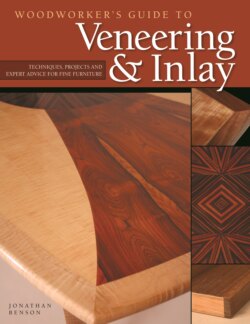Читать книгу Woodworker's Guide to Veneering & Inlay (SC) - Jonathan Benson - Страница 17
На сайте Литреса книга снята с продажи.
Clipping
ОглавлениеSheets of veneer are clipped, or cut straight along both long edges, to create sheets or leaves of uniform size with straight, uniform edges. Clipping usually removes the sapwood from each sheet.
Some wood species, and many burls, are available not clipped and have a rough or natural edge. With burls, which usually are odd-shaped before they are cut, the lack of clipping greatly reduces waste. Also, rough-edged veneers are good for capitalizing on the contrast between the sapwood and heartwood of a particular species because the sapwood has not been trimmed (Figure 2-15).
After clipping, veneer sheets are run though a dryer for specific times and temperatures, depending on thickness and species of wood. The sheets are then restacked in the order in which they came off the log and kept in a humidity-controlled environment until being shipped or used. Veneer sheets that require paper backing receive it at this point in the production process. Veneer without any factory backing or adhesive is known as “raw” veneer.
